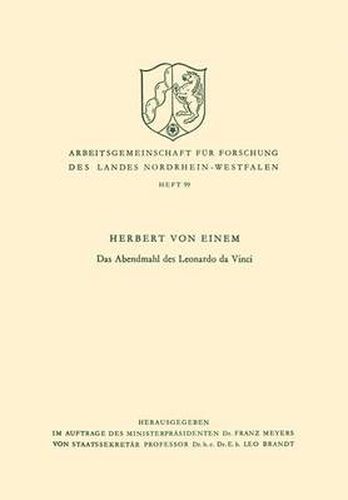Readings Newsletter
Become a Readings Member to make your shopping experience even easier.
Sign in or sign up for free!
You’re not far away from qualifying for FREE standard shipping within Australia
You’ve qualified for FREE standard shipping within Australia
The cart is loading…






This title is printed to order. This book may have been self-published. If so, we cannot guarantee the quality of the content. In the main most books will have gone through the editing process however some may not. We therefore suggest that you be aware of this before ordering this book. If in doubt check either the author or publisher’s details as we are unable to accept any returns unless they are faulty. Please contact us if you have any questions.
In Italy, and especially in Tuscany, the Last Supper has served as a regular theme for refectory pictures - the monks’ daily meal serving as a remembrance and imitation of the sacred meal, which is at the same time a promise- bread and wine as the body and blood of the Lord shed for many for the remission of sins . Representations of the Last Supper have been bound up in oriental and western art since the ninth century with the announcement of the betrayal. But the betrayal is a secondary theme. The crucial point lies in the institution of the eucharistic feast. Does Leonardo’s Last Supper (painted, it is supposed, between 1495 and 1498 for the refectory of St. Maria delle Grazie in Milan) meet these intellectual and spiritual demands ? Or does the hallowed subject merely serve Leonardo as pretext for the treatment of representational and psycho- logical problems? This talk is devoted to finding an answer to this question. The claims of the theme are ideally met in the oldest Italian representation of the Last Supper intended for the decoration of a refectory, the fresco ascribed to Taddeo Gaddi in S. Croce, Florence (middle of the 14th century).
$9.00 standard shipping within Australia
FREE standard shipping within Australia for orders over $100.00
Express & International shipping calculated at checkout
This title is printed to order. This book may have been self-published. If so, we cannot guarantee the quality of the content. In the main most books will have gone through the editing process however some may not. We therefore suggest that you be aware of this before ordering this book. If in doubt check either the author or publisher’s details as we are unable to accept any returns unless they are faulty. Please contact us if you have any questions.
In Italy, and especially in Tuscany, the Last Supper has served as a regular theme for refectory pictures - the monks’ daily meal serving as a remembrance and imitation of the sacred meal, which is at the same time a promise- bread and wine as the body and blood of the Lord shed for many for the remission of sins . Representations of the Last Supper have been bound up in oriental and western art since the ninth century with the announcement of the betrayal. But the betrayal is a secondary theme. The crucial point lies in the institution of the eucharistic feast. Does Leonardo’s Last Supper (painted, it is supposed, between 1495 and 1498 for the refectory of St. Maria delle Grazie in Milan) meet these intellectual and spiritual demands ? Or does the hallowed subject merely serve Leonardo as pretext for the treatment of representational and psycho- logical problems? This talk is devoted to finding an answer to this question. The claims of the theme are ideally met in the oldest Italian representation of the Last Supper intended for the decoration of a refectory, the fresco ascribed to Taddeo Gaddi in S. Croce, Florence (middle of the 14th century).